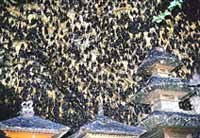|
Goa Gajah (elephant cave) and Goa Lawah (bat cave) are
two frequently-visited historical sites in Bali that contain
many significant meaning for Balinese Hindus.
Situated in Bedulu Village, Gianyar, Goa Gajah is believed
to have been carved from a hillside as a monastery in the
11th century, though it wasn't rediscovered until 1923.
The name of this cave is probably taken from the nearby
Petanu River, which at one time was known as Elephant River,
or possibly because the entrance to the cave resembles an
elephant. It is used by the Balinese as a holy place for
worshipping the God Shiva and his elephant-headed son Ganesha.
Buddha statues and fertility symbols can be found inside
the cave, suggesting that it had a long history of religious
use. Today, it is a cool, dark place to contemplate Bali's
distant past.
The origins of the cave are uncertain. One tale relates
that it was created by the fingernail of the legendary giant
of Kebo Iwo. It probably dates at least to the 11th century,
and it was certainly in existence at the time of the Majapahit
takeover of Bali. The cave was rediscovered by Dutch archeologists
in 1923, but the fountains and bathing pools were not unearthed
until 1954.
Inside the T-shaped cave you can see fragmentary remains
of Lingam, the phallic symbol of the Hindu God Shiva, and
its female counterpart the Yoni, plus a statue of Shiva's
son, the elephant headed God Ganesha. In the counter yard
in front of the cave are two square bathing pools with water
gushing into them from waterspouts held by six female figures.
To the left of the cave entrance, in a small pavilion, is
a statue of Hariti, surrounded by children.
Located on southeast coast of Bali in Wates Village, Goa
Lawah (bat cave) is on the border between Klungkung and
Karangasem regencies. This cave is located in the inner
yard of a temple compound.
 A
distinctly batty stench exudes from the cave and the roofs
of the temple shrines in front of the cave are liberally
coated with bat droppings. Superficially, the temple is
small and unimpressive, but it is very old and of great
significance to the Balinese. Goa Lawah Temple is one of
the island's nine special Sad Kahyangan Temples, and as
such it is the designated holy place to honor the God Maheswara,
who resides in this section of the island. Religious processions
visit the temple every day, and it is a particular focus
for religious rites associated with death. A
distinctly batty stench exudes from the cave and the roofs
of the temple shrines in front of the cave are liberally
coated with bat droppings. Superficially, the temple is
small and unimpressive, but it is very old and of great
significance to the Balinese. Goa Lawah Temple is one of
the island's nine special Sad Kahyangan Temples, and as
such it is the designated holy place to honor the God Maheswara,
who resides in this section of the island. Religious processions
visit the temple every day, and it is a particular focus
for religious rites associated with death.
In front of the cave are small shrines of a Shivaite temple
guarding the cave's entrance. This site has been worshipped
since around 1000 A.D., and was founded by an itinerant
holy man, named Resi Markandya (a holy priest from Java).
The cave is also said to lead all the way to Besakih, but
nobody has yet volunteered to confirm this since the bats
provide sustenance for the legendary giant snake, Naga Basuki,
which is also believed to live in the cave. This ancient
reptile is believed to be the caretaker of the earth's equilibrium,
a belief which stems from pre-Hindu animism.
| 






